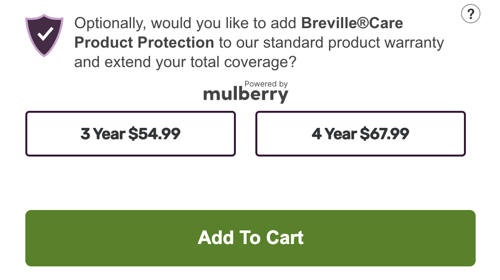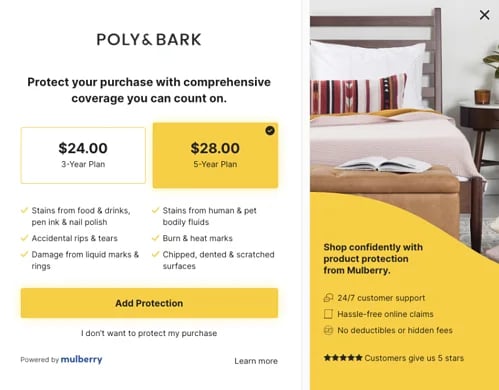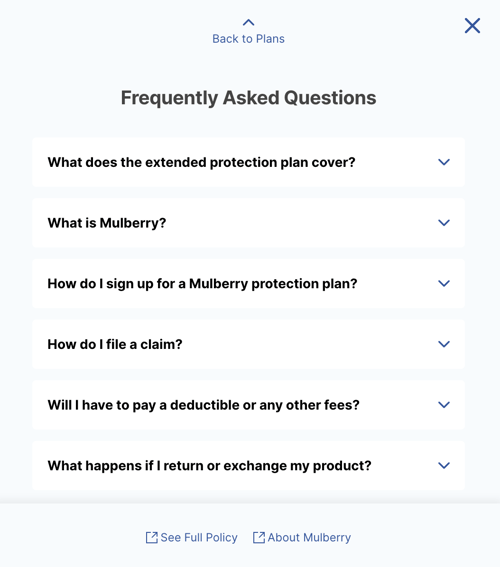So you’re ready to offer protection plans for the products on your ecommerce website. Maybe you’ve heard request after request from customers who want extended or accidental coverage, or maybe you’ve realized the incredible revenue potential of adding an extended warranty program. Either way, it’s great that you’re exploring this revenue driver that can improve how you serve your customers. As you start down the path to launch an extended warranty program, here are four factors to consider to map out a successful program.
1. Coverage
The first step is to determine what product protection plans you want to offer. These plans will serve as another product that you are offering your customers, so you want to figure out what type of coverage will be most relevant and valuable to them.
Do you want to offer extended coverage for product defects after the manufacturer’s limited warranty period or subscription service protection plan? Do you want to offer accidental coverage for protection against spills, scratches, or other issues? What timeframes are most relevant - 2 year, 5 year, something else?
The answers to these questions will depend on your product category and what sort of limited warranty you already offer. In the end, you don’t need a lot of plans for launch - for example, a single level of coverage with two options for warranty length can keep things simple for your customers. You can always test out alternative plans post-launch during ongoing optimizations.

2. Pricing
Aside from coverage, pricing is the most important factor customers use to decide whether or not to purchase a protection plan. It may take some testing to find the right balance of high attachment rates and high margins (the higher the cost, the higher the margins, but fewer customers are likely to buy the plan).
Some retailers choose to offer their protection plans at a loss in order to improve overall site conversion rates, while other retailers choose to use their warranty program to drive up average order value (AOV). When figuring out a price for launch, first and foremost consider the cost of the plan in relation to the cost of the product. And when offering multiple plan options, think about which plan you want to encourage more than the other and how you can scale pricing up/down for each plan to encourage that behavior. For example, a retailer looking to promote longer-term protection plans may want to offer a 3 year warranty for $25 and a 5 year warranty for $30, incentivizing customers to choose the 5 year plan because it’s a greater value.
Estimate your extended warranty revenue
Share a few details about your products and ideal program and our team will follow up with a profit estimate
3. Placements
Once you have your protection plan offers set, the question is, where will you be placing these offers? Consider all of the available options along the customer journey -- pre, during, and post checkout. A combination of placements can significantly increase attachment rates and provide insight into where your customers are most likely to add protection plans.
Ideal placement options include: product pages near the Add to Cart button or in a pop-up modal, in the shopping cart or checkout page or drawers, on the confirmation page post-checkout, and post-purchase campaigns through email and SMS. Pre-purchase placements can help drive conversions from cautious shoppers, in addition to all of the other benefits of the product protection program. These placements also tend to have the highest attachments rates. Meanwhile, post-purchase placements give retailers another opportunity to interact with customers and help serve customers who wanted to add a protection plan but forgot to do so during checkout.

4. Marketing
Finally, it’s time to turn to how to best market these offers beyond their placement. Marketing considerations include what language to use in protection plan call-to-actions (CTAs), FAQs, and other content. Here are a few tips for crafting effective - and compliant - language:
- Prioritize clarity: When in doubt, use language that is clear to consumers. For example, “Add accident protection” is much clearer than “Add more coverage”.
- Stay compliant: Work with your product protection partner to figure out which language you can and can’t use to stay compliant with laws around product protection plans.
- Highlight differentiated value: Be sure to surface key benefits included with a product protection purchase, such as great customer service, and explain the difference between these plans and other warranties already included.
- Explain how it works: Customers often want to understand what the experience is if they want to use their extended warranty, so share a bit about what they can expect.
- Talk about coverage: Coverage details are one of the most important factors consumers consider when purchasing a protection plan, so highlight what they get.
- Keep it transparent: Be clear about which company you’re partnering with to deliver these product protection plans, so that if/when a customer needs to use their warranty, they’re not confused about who to work with.

Next Step: Optimization
Remember that, after you launch, there’s a lot of opportunity to optimize each and every aspect of your product protection program! After some initial data collection around the success of your program, think about what you’d like to test in each of the above areas. For example:
- Coverage: If you initially launched with extended coverage that focuses on product defects and malfunctions, try offering a plan that includes accidental coverage.
- Pricing: See how scaling pricing up or down impacts attachment rate, or even try out promotions to offer plans at a dramatically low price in order to improve overall site conversion rate.
- Placements: Try out new placements you didn’t initially launch with to see how many more customers engage. If you started on-site, try out a post-purchase campaign, or if you started with a post-purchase placement only, consider adding the offers on-site.
- Marketing: For each of your placements, try out different wording or styles to see the impact on attachment rates.
An extended warranty program can offer significant revenue growth while serving up valuable protection customers want. With these key factors mapped out and customized to your business goals and customer needs, you’ll be ready to launch your first product protection program.





